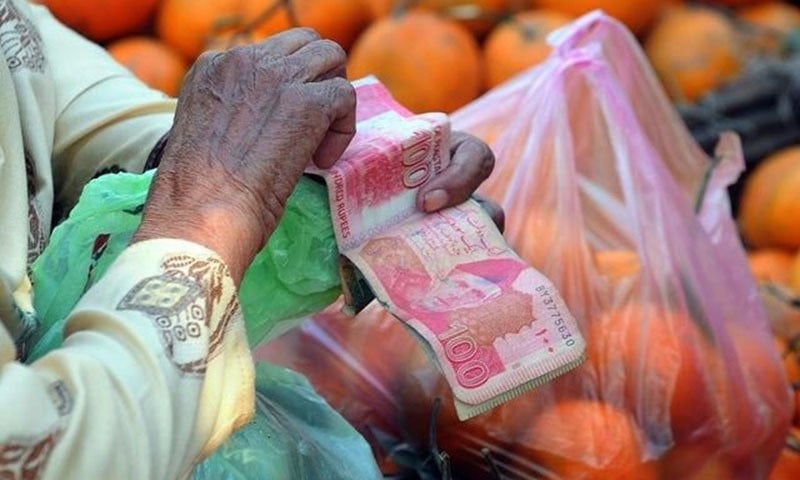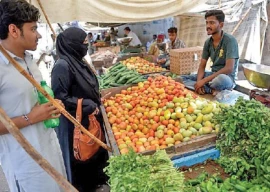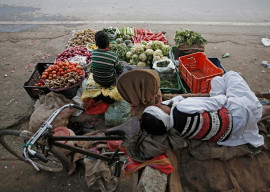
The inflation rate in the country soared to 13.8% in May -- the highest pace in nearly two-and-a-half years -- because of an exponential growth in the prices of perishable food and transport groups, the Pakistan Bureau of Statistics (PBS) reported on Wednesday.
The pace of increase in the prices was in line with the finance ministry’s forecast but lower than the market expectations that saw the reading hitting 14.5%.
The decision to use the average Rs980 per 20 kg bag of wheat flour price, which was based on same minimum and maximum rate almost across Punjab, particularly in Lahore, might have played a role in relatively low inflation reading of 13.8% last month.
The PBS had used these rates in the last Sensitive Price Index, which had a reflection on the monthly inflation date.
The core inflation being calculated after excluding the volatile energy and food prices also jumped to 11.5% last month in rural areas -- signalling a price growth gathering pace across most categories of goods and services.
The PBS reported that the 13.8% rate was the highest pace since January 2020 when the inflation was recorded at 14.6%.
It was the first reading that the national data collecting agency reported after Prime Minister Shehbaz Sharif allowed the government to increase fuel prices by Rs30 per litre or up to 25.4% on May 26. Another round of increase in fuel prices is expected to pave the way for the revival of the International Monetary Fund (IMF) loan programme.
The inflation rate for communication groups has increased to nearly one-third in May.
A day earlier, the IMF had again said Pakistan needed to immediately withdraw subsidy on petrol and energy to repair damaged macroeconomic stability.
Overall, out of 12 groups of various goods and services, the inflation rate for 10 of them remained in double digits. This indicates that the inflation web has spread across almost all the commodities.
The PBS reported that CPI-based inflation rate increased to 12.4% in urban areas and 15.9% in villages and towns. The constant double-digit inflation in the country has adversely affected the people’s purchasing power.
The overall price growth remained in double digit because of an increase in the rates of food items, which were taxed by the last government.
The pace of food inflation slightly decelerated to 15.5% in cities and but skyrocketed to 19% in villages and towns last month, according to the PBS.
The prices of both non-perishable and perishable food products increased significantly last month. The food group prices surged over 17.3% in May in comparison with the same month a year ago. The PBS said the prices of perishable food items increased by 26.4%.
Read Food inflation rises unchecked
The average price of wheat flour in Lahore has touched Rs1,082 and to Rs1,288 in Islamabad, showing for the first time a difference of Rs206 per 20 kg bag.
While reporting the Sensitive Price Index last week, the PBS used minimum and maximum Rs980 per 20 kg wheat flour price for all cities of Punjab except Rawalpindi where minimum was same but maximum was Rs1,352 per bag.
This suggested that in Rawalpindi, the gap of 20 kg bag was Rs372 in the same city.
Earlier on May 12 and in other weeks, the prices in Punjab were shown between Rs1,300 to Rs1,400 per 20 kg bag.
The PBS reported that CPI-measured non-food inflation increased by 10.4% in urban areas and 13.1% in rural areas.
The core inflation – calculated after excluding food and energy goods – jumped by 9.7% in urban areas and 11.5% in rural areas.
The State Bank of Pakistan last month further increased the key policy rate to 13.75% to curb the spiralling inflation and correct external sector imbalances. The central bank has so far failed to contain the inflation despite almost doubling the interest rates.
The prices of all essential products seem to be slipping out of the control of the authorities, particularly the crucial kitchen items like edible oil.
The prices of tomatoes were higher by 162% last month in comparison with the same period a year ago, followed by a 153% increase in the rates of onions and over 60% of various types of ghee and cooking oil, according to the PBS.
The prices of pulses increased by nearly half and meat and vegetables by one-fourth last month in comparison with a year ago.
The rates of liquefied hydrocarbons doubled in May against a year ago, followed by 44% growth in petrol prices and 20% in prices of cars.
However, the electricity was 11% cheaper last month in comparison with a year ago due to the Rs5 per unit subsidy that the IMF now wants to withdraw.
The average inflation during the first 11 months (July-May) remained in double digits and shot to 11.3% -- far higher than the government’s target of 8% and the initial projection made by the SBP.




1732256278-0/ellen-(1)1732256278-0-165x106.webp)
1725877703-0/Tribune-Pic-(5)1725877703-0-165x106.webp)
















COMMENTS
Comments are moderated and generally will be posted if they are on-topic and not abusive.
For more information, please see our Comments FAQ